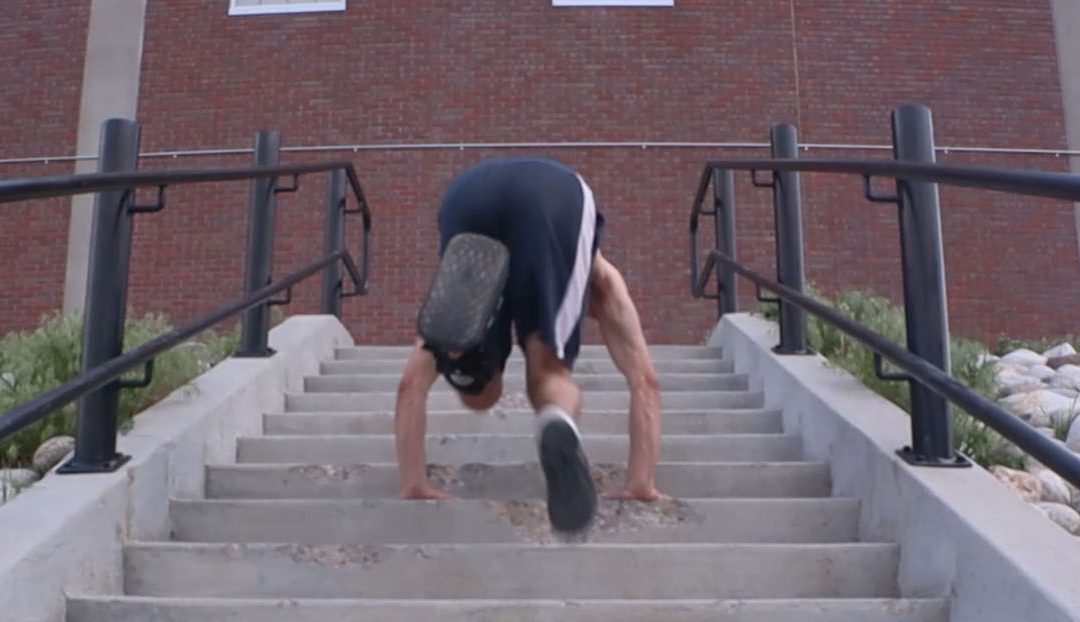It’s something nearly everyone experiences at some point in their lives – the sudden helplessness that accompanies an injured limb. Minor tasks become ordeals. You have to rely on others. It’s humbling. On top of this, maintaining a fitness routine, which takes effort and discipline under ideal circumstances, now feels too risky or difficult. Sadly, many folks just stop, saying they’ll get back to it once the injured part heals. Oftentimes they never do.
Someone who practices parkour thinks about this problem a lot differently. An injured limb, once recovered past the initial stage, is an opportunity to learn new movement patterns. Parkour, down at its roots, simulates emergency situations and how to use movement to overcome them. In our 50+ program PK Silver, we imagine the circumstances that might lead to a fall around the house, and practice movements that can be activated if one actually happens. Similarly, the situation of being hurt but still needing to find your way around absolutely fits the spirit of parkour.
PK Move Director Sean Hannah is currently experiencing such an opportunity, having injured his leg last month. With his lower leg immobilized in a boot, Sean has been practicing his tripedalism (moving with three limbs) to get around the house and train the rest of his body. In parkour, movement never stops. It merely adapts to each new circumstance.
If you experience an injury and need to keep moving, keep the following principles in mind:
1. Inactivity is not an option…for long. Going inactive for too long after an injury is not just bad for your body as a whole, but slows down the recovery process. Of course you need some time away from movement when you experience an injury. Your body won’t fall apart in a couple of weeks, provided your diet is healthy. But after that, your fitness will begin to decline steadily. Muscles and tendons need to “get a pump” into them regularly, however minor, to repair and maintain their function. It’s how they’re designed. So use your brief inactive period to strategize what you can do once your doctor clears you for exercise again.
2. There’s other problems to solve. Most injuries are the result of overuse and/or muscular imbalance. Chances are, your injury isn’t the only part of you that has issues. Now’s the time to focus on one or two other problems you might have – the ankle sprain that never fully healed, that clicky shoulder, etc. – so that when your injured part is usable again, your general body function is not just restored but improved.
3. Patience is (still) a virtue. Injuries take longer to fully heal than most people realize. Understand this – physical therapy is only the start of a recovery. 6-8 weeks (the typical length of time spent with a PT for most sports injuries and post-operative treatments) is enough time to restore basic function to an injured joint or limb, but the work to restore full function takes months, sometimes years, depending on the level of movement you’re trying to get back to. Don’t get discouraged. Get curious! Learn how your body works. Each injury is a chance to educate yourself on how that part functions and what movements restore its strength. Become fascinated by the rebuilding process. There are many great FREE resources online to help you understand how to approach your own recovery, like the Bob & Brad channel on YouTube. Become addicted to the little bits of progress you make day by day, and pretty soon a year’s gone by and you’re doing what you love again (or finding something new to love) instead of saying “I used to…”
4. Creativity rules. When you can’t do what you want, you have to start over with what you have and recognize opportunities for new growth. Leg is hurt? Practice standing on the other one. It will become stronger and more stable, which keeps you safer in motion while the hurt leg recovers. Dominant arm is hurt? Learn to cook and eat with the other arm instead of using DoorDash. The same goes for your exercise routine. Now’s a great chance to practice unilateral activities. That is, using one side of the body. You can focus on whatever weaknesses exist in the non-injured limb and make it stronger, giving your injured limb an even higher baseline to return to once it’s ready to begin exercising again.
Don’t let an injury slow you down any more than it needs to. There’s always a way to keep moving!

For us older adults, we often have medical professionals tell us that decreasing strength and mobility is “normal” as we age, and that restricting our movement to just walking or swimming for example is “safer.” Thanks for getting the message out, and especially for encouraging us to be creative and use our whole bodies.
And I also love the Bob and Brad videos on YouTube. 🙂
Thank you Amanda! Play IS what’s normal. Or should be 😉